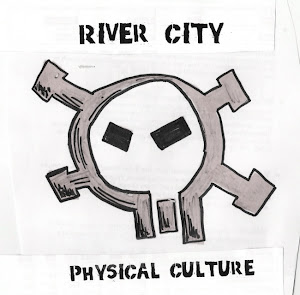The Push Press is the middle sister on the continuum of vertical pushes...
First there's a strict press, military press, what have you. A motion that isolates the shoulder girdle and the muscles of arm extension and abduction(as much as any exercise can isolate) in their role of lifting the bar overhead.
Next you have the push press, where the hips are used to drive and create momentum on the bar that is then guided by the arms and the movement is completed by the locking out of the arms, typically against resistance, so here the role of the arms and shoulders have been reduced to say 50% of the equation.
Finally there is the jerk, where the hips drive the bar to a predetermined height, as the knees rebend to lower the body, allowing the athlete to catch the bar with the arms locked out overhead, with little or no work from the shoulders/arms. In the jerk, the load placed upon the arms should ideally be 25% or less.
Today I am pointing out some of the different ways people 'push' press, whether it be the way they teach or the implements they use.
Here's the first peice; Pat from Crossfit VA Beach teaching the dip portion-if you've been powerlifting for a while, the 'hips back' habit is hard to break!
Check it out
Here's one of the athlete's from Mike's Gym doing a barbell push press
check this out
Now, here's Valery Fedorenko of the AKC doing a few KB push presses. It's only one pood, but he completes several repetitions :)
The KB is very good for developing confidence, stability and mobility in the shoulders during lockout. The barbell is wonderful for incremental changes in load. Other common implements include dumbbells, sandbags, kegs and logs. Dumbbells are dumbbells. Sandbags vary so much in shape, density and solidity that it's difficult to generalize. Almost always, they are more difficult to press or jerk than their bar or bell equivalent. Kegs of course are like that too, but at least they have handles. They are only really heavy if they are filled (with liquid of course!) so they are all 'sloshy'. An 'odd' object overhead is almost always humbling and often as much psychological training as it is strength. In the beginning, I recommend sticking to bars, bells and the occasional Dynamax ball.






2 comments:
That looks pretty cool. I guess it is good for the back too?
well- primarily the push press is more of an integrated power movement, but yes, all overhead support movements (press, squat etc) can have benefits for the entire core, including the back, when done correctly.
Post a Comment